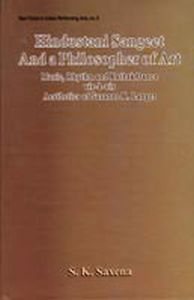
Contents: Preface. 1. Langer’s theory of art : some essentials. 2. Of music : Langer and an Indian genre. 3. Imaging time in music : Langer and Hindustani rhythm. 4. Magic in movement : Langer and Kathak dance. Bibliography. Index.
"The book is decidedly the very first of its kind. It seeks to weigh some basic facts and concepts of Hindustani sangeet (music, rhythm, and Kathak dance) against the art theories of Susanne K. Langer, an eminent aesthetician of the recent past; but nowhere without meticulous attention to the text of her writings.
"The expression theory of art has for long dominated the history of aesthetics. At the hands of Langer, however, the theory takes a new turn. She conceives of art not as a direct self-expression of the artist’s immediate affective state, but as a symbolic expression of his knowledge of what she terms variously as felt life, sentience, or forms of feeling. Drawing freely upon examples from the region of Hindustani sangeet, the present book accepts Langer’s protest against the popular view of artistic expression, but contends that there is a good deal in our music and dance which has nothing to do with feeling, and is admired simply because of its sweetness, clarity, shapeliness, and accordance with grammatical norms.
"In the chapter on music, while discussing Langer’s emphasis on ‘commanding form’ in a total performance, the author proposes a quite new definition of raga which seeks to integrate the various points in its traditional characterizations. The third chapter too, which deals with Langer’s view of rhythm, is not merely explanatory, but ventures to propose a fresh and fairly defensible definition of rhythm.
"The closing chapter, devoted to dance, not only essays to meet some key objections to Langer’s writing on this art, but clarifies some atypical language that she uses in this context: apparition of vital powers; the dynamic image; virtual realities; and the created, ‘superhuman’ dance-personality.
"But perhaps the two most striking features of the book are: first, a lucid exposition of the essentials of Langer’s aesthetics in the opening chapter; and, second, abounding illustrative references to Hindustani sangeet." (jacket)
